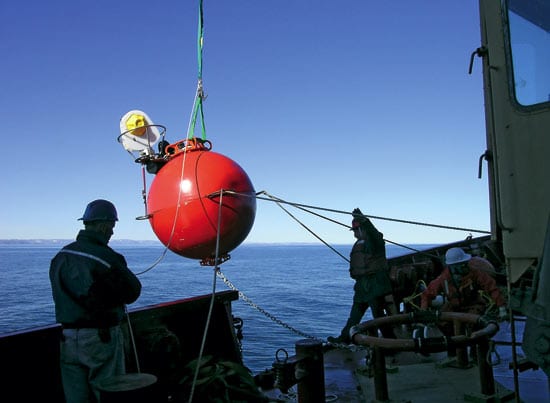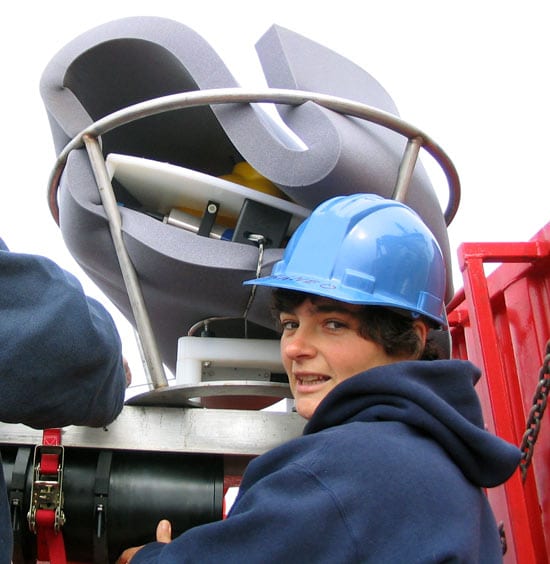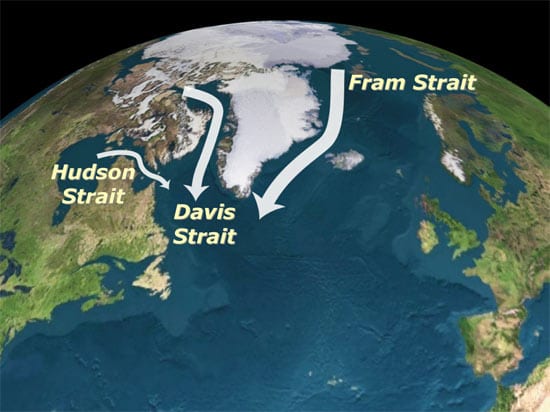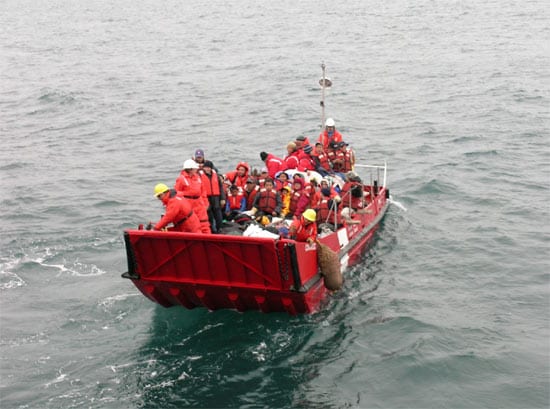
A Sentry at the Atlantic Gateway
Experimental mooring monitors water flow through Hudson Strait
Here’s an easy recipe to change Earth’s climate: Just add more fresh water to the North Atlantic Ocean.
In this oceanic part of the world lies a critical—and sensitive—component of the heating and plumbing system that regulates the planet’s climate. Messing with it is like tampering with the thermostat in your house.
Warm, salty, equatorial waters flow via the Gulf Stream to the North Atlantic. In winter, they confront cold air and release heat to the atmosphere, making winters in North America and northern Europe milder. The waters—still salty and now colder—become denser and sink to propel a global system of currents called the Ocean Conveyor.
Adding fresh water throws a monkey wrench into the system. It is much lighter than, and floats above, saltier water. The fresh water can form a cap that can block the deeper warm waters from surrendering their heat and that can slow down the Conveyor. Geological evidence has shown that this has happened many times in the past and caused significant climate changes.
Changes upstream of the gateway
Looming over the North Atlantic is the Arctic region, a large reservoir of relatively fresh water. It includes the Arctic Ocean and major Arctic and subarctic inland seas such as Hudson Bay. The region is filled with sea ice, which releases salt from seawater when it forms. The salt sinks, leaving fresh water at the surface. In addition, innumerable rivers drain precipitation over the continents into the Arctic. The fresh water is funneled out of the eastern end of the Arctic region through several small straits.
“Not surprisingly, then, climate scientists are very interested in monitoring these straits that act as freshwater gateways to the North Atlantic,” said Fiamma Straneo, a physical oceanographer at Woods Hole Oceanographic Institution (WHOI). “We have evidence that changes are happening upstream—in the rivers, in the sea ice, in the Arctic Ocean—but we do not know how these changes are affecting the freshwater discharge to the Atlantic, which is crucial if we are to understand our changing climate.”
The critical 50 meters just below the ice
Straneo set sight on one gateway, Hudson Strait, which shunts large amounts of fresh water accumulated in Hudson Bay into the Labrador Sea. No one had ever measured or monitored Hudson Strait before, because it lies in a remote region, full of swift, strong currents, sea ice, and icebergs that are daunting for researchers and hell on instruments. Straneo needed funds, instruments that could endure the harsh environment, and a ship to get her there.
The funds came from the WHOI Ocean and Climate Change Institute, through a grant from the Comer Science and Education Foundation, to deploy a mooring in Hudson Strait. “This type of project wouldn’t be easily funded by a government agency at this stage, because the risk is large,” Straneo said.
Next, she assembled a variety of instruments that measure current velocities, water temperature and salinity, and ice thickness. The instruments would be attached to a mooring line anchored to the seafloor that would extend 50 meters (164 feet) below the surface. Still, she needed critical measurements from those last 50 meters, where much of the fresh water flows.
“But if we put an instrument up there, sea ice or icebergs would surely sweep it away,” Straneo said.
To get around this obstacle, WHOI engineers Dan Frye and Steve Liberatore designed and built a new instrument called the Arctic Winch. Housed on the mooring’s top flotation sphere, the winch periodically unspools a float with a number of sensors, which rises to the surface while collecting data.
“When it hits sea ice or the surface,” Straneo said, “it is programmed to come back down immediately. So it gets measurements up to the surface, without spending time there waiting for ice to get hold of it.”
Land of the Inuit
With instruments and funds in hand, Straneo now needed to find a ship that would take her to an area where few ships go. She fostered a collaboration with Canadian scientists conducting research in Hudson Bay aboard the Canadian Coast Guard icebreaker Pierre Radisson. They agreed not only to take her, but also to deploy two supporting moorings to get better measurements of the freshwater flow across Hudson Strait.
In August 2004, Straneo and WHOI engineer Jim Ryder flew to Puvirnituq, a small Inuit village on Hudson Bay in Nunavik, Quebec’s Arctic region, to rendezvous with the icebreaker. Waiting for the ship, they spent a day talking to the locals who shared stories of caribou crossings, fishing and hunting on ice, and the difficulties that Inuit communities are experiencing as they transition to a less nomadic way of life.
“Not many people visit these isolated villages,” Straneo said, “so people are curious and eager to talk. There is no road access to this region and necessary goods are brought in by ship only two times a year.”
When the icebreaker arrived, Straneo and Ryder flew aboard by helicopter. While the Canadians conducted their research, Straneo anxiously waited her turn. In the Arctic, something—often bad weather—can always arise at the last minute to ruin the best-laid plans.
With the WHOI mooring gear ready on deck, the Radisson’s captain was notified that 40 Inuits were stranded on Nottingham Island some 200 miles away. If the ship turned around straightaway, there would have been no time to come back to Hudson Strait. Luckily for Straneo, the captain ascertained that the Inuits were in no immediate danger, so they proceeded with deployment. It was a sunny, warm day, and a few icebergs calmly drifted down the strait.
Will the experimental instrument work?
With her instruments in the water, Straneo returned to WHOI. The wait seemed eternal.
“You don’t know if the instruments are working, or even if the mooring is still there until you get back one year later,” she said. “It is quite nerve-wracking.”
In September 2005, Straneo and the Radisson returned to Hudson Strait. “Few things can beat the excitement of spotting the large red flotation sphere rising to the surface after we released the mooring from its anchor,” she said.
The Arctic Winch had worked for the entire year, though it had difficulties reaching the surface—probably because of strong surface currents that sometimes exceeded 5 knots. With the data in hand, the winch can now be improved for future deployments. And it took crucial measurements from those key 50 meters—a big success.
“For the first time,” Straneo said, “we will be able to calculate the Hudson Strait freshwater outflow. The next questions are, ‘Is it changing? How? Why?’ ”
From the Series
Slideshow

Slideshow
- OVER THE SIDE AND UNDER THE ICE A big red flotation sphere the top part of a mooring 180 meters (590 feet) long?is deployed into Hudson Strait. Over a year, the experimental mooring collected the first detailed measurements of water flowing out of icy Hudson Strait and into the North Atlantic. Changes in the outflow can have impacts on the climate in the North Atlantic region. (Photo by Fiamma Straneo, Woods Hole Oceanographic Institution)
- TESTING AN EXPERIMENTAL DEVICE WHOI oceanographer Fiamma Straneo deployed an experimental mooring in the ice-covered Hudson Strait in 2004 to measure the flow of water through this climatically significant gateway to the Atlantic Ocean. She had to wait a year to retrieve the mooring to see how it worked. (Photo courtesy of Fiamma Straneo, WHOI)
- GATEWAYS TO THE ATLANTIC The Arctic region contains a large reservoir of relatively fresh water. The fresh water is funneled out of the eastern end of the Arctic region through several small straits. Changes upstream of the gateways may be affecting the freshwater discharge to the Atlantic, which can cause changes in ocean circulation and climate. (Illustration by Jack Cook, Woods Hole Oceanographic Institution)
- RESCUED Just before WHOI oceanographer Fiamma Straneo was ready to deploy her mooring, the ship's captain was notified that 40 Inuits were stranded on an island 200 miles away. Luckily for Straneo, the captain ascertained that the Inuits were in no immediate danger, so Straneo did not have to scrap her only chance for the year to deploy her mooring. The mooring deployment proceeded, and then the ship picked up the stranded Inuits. (Photo by Fiamma Straneo, WHOI)
Video
Related Articles
Featured Researchers
See Also
- Is Global Warming Changing the Arctic? from Oceanus magazine
- Flying Blind in the Ice Factory from Oceanus magazine
- The Flywheel of the Arctic Climate Engine from Oceanus magazine
- Under-ice Floats Offer a ?Breakthrough? from Oceanus magazine
- Monitoring the Freshwater Flow into the Atlantic through Hudson Strait
- Fiamma Straneo Fiamma Straneo's research on ice-ocean interactions
- Fresher Ocean, Cooler Climate A less-salty North Atlantic Ocean could cool northern winters.
- The WHOI Ocean and Climate Change Institute



